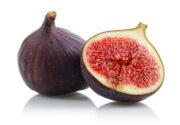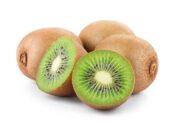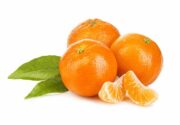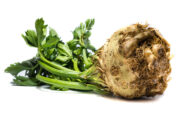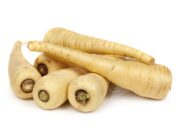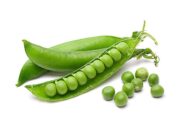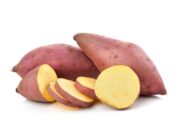November lets us use the last of fall's seasonal fruit harvest while also enjoying winter citrus that show up this month (like grapefruit, kumquats, and clementines).
This month also brings cool weather produce into the kitchen that's great for roasting, cooking into soups, and adding to salads.
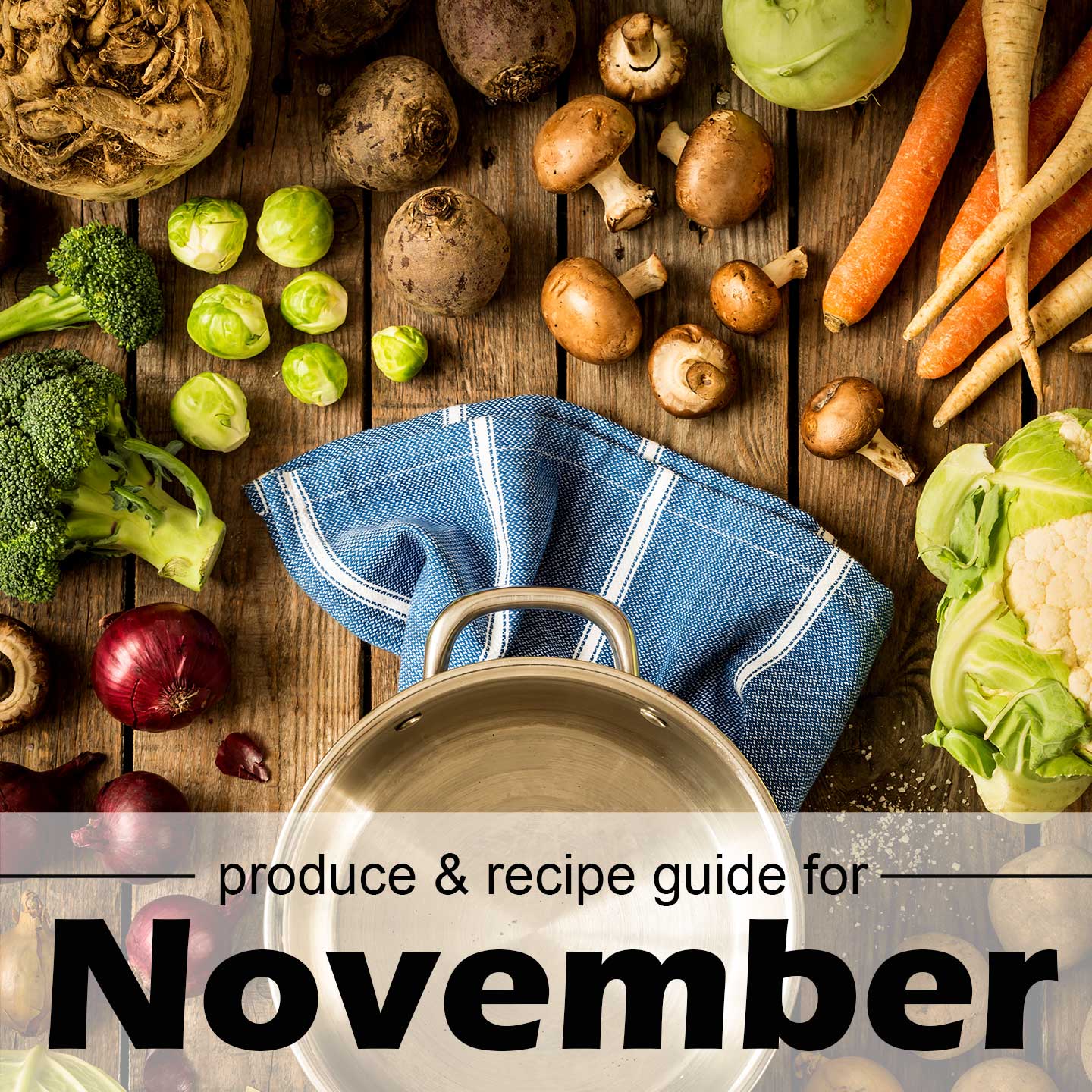
This produce guide highlights the fruit and vegetables in season this month along with recipes for you to enjoy.
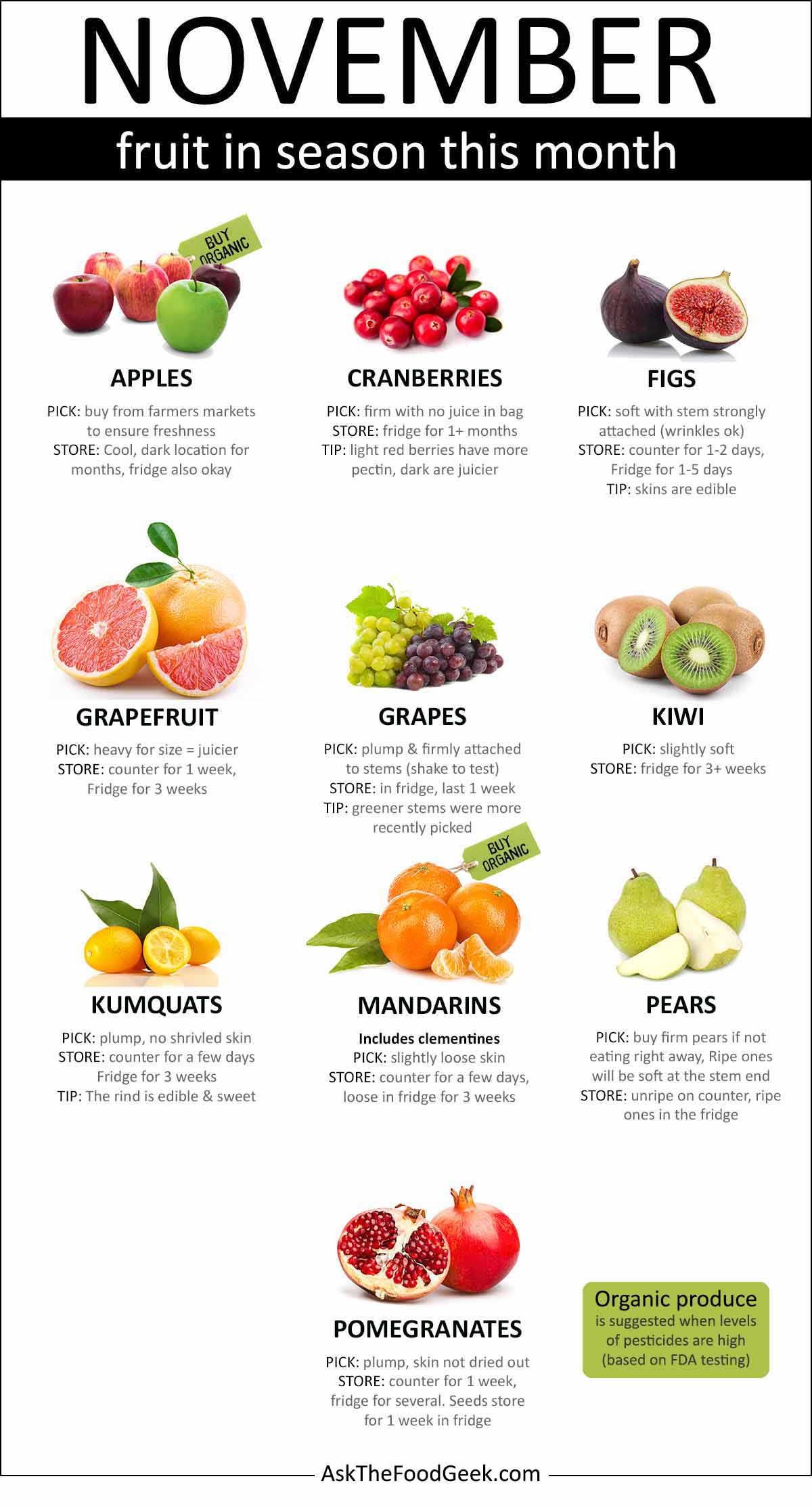
Fruits in season
The best fruit in November will be late season apples, pears, and cranberries. They will all be readily available and high quality. The other fruit seasons are either starting or ending and can be a little more sporadic or harder to find.
Apples
Some of the best fruit this month are late season apples:
- Braeburn and Northern Spy are the best apples for pie this late in the season
- Fuji is best for fresh eating
- Pink Lady are great for cheese boards and salads, since they are slow to brown
- Golden Russet and Winesap are a top notch option for making cider due to their natural pie-spice flavors
Pears
Bartlett pears are best for eating fresh, but use Bosc or D'Anjou in baking as they will hold up better in high heat. Comice are great for a cheese board.
Cranberries
These tart little berries are in season from September through December. But they get overlooked outside of Thanksgiving's cranberry sauce recipes.
Try using cranberries to add a bright flavor to stews, a tray of roasted vegetables, salad dressing, or on top of a cheesecake.
50+ seasonal cranberry recipes
Pomegranates
Fresh pomegranates are available at stores this month. One pomegranate usually has 6-8 ounces of seeds (also called arils), and they are great on fall salads or roasted vegetables.
Figs
November marks the end of fig season, so now is your last chance to buy this fruit. Their flavor is perfect for fall, especially when roasted with vegetables, added to a fall salad, or baked into a warm dessert.
Grapes
While grocery stores provide grapes year-round, they are only in season in the US from June through November. Try roasting them and adding to a salad, on top of sweet potatoes, or alongside steak. Roasting softens the fruit, tames the acidity, and gives them an almost honey-like sweetness.
Kiwi
Kiwi season starts in fall and continues into spring for US-grown fruit. (The ones we get in summer are imported). Try using kiwi as a marinade this month - the enzymes in kiwi have unique meat-tenderizing qualities.
Grapefruit
Grapefruit in season starting in November from Texas and Florida. Ruby Red and Flame grapefruit tend to be the sweetest varieties, and pink grapefruit are often less bitter.
On a cold fall night, try roasting chicken with a grapefruit-honey glaze, replace spring rolls with winter rolls dipped in a grapefruit-hoisin sauce, or some caramelized grapefruit for dessert. Get these grapefruit recipes and more.
Mandarins
Mandarin and clementine season starts in November, often sold under the Halo or Cutie brands. The fruit is usually sweeter later in the season, however. This month, try using them to make a citrus & herb roasted turkey.
Kumquats
Kumquats are tiny little citrus fruits the size of grapes with a sweet & sour flavor. The entire fruit is edible - the rind is sweet and aromatic while the flesh is very tart. The seeds, while edible, are usually spit out because of their bitterness.
Try a kumquat upside down cake and other kumquat recipes.
Produce guides for fruit
Check out the produce guides for selection & storage tips, seasonal recipes, and more, for the fruits in season this month.

Vegetables in season
The cool November weather is perfect for roasting root vegetables (like parsnips and sweet potatoes), brassicas (like brussels sprouts), and winter squash (like pumpkins and butternut squash).
Brussels sprouts
Roasting brussels sprouts brings out the sweet and nutty flavors, while also taming their bitterness. Adding bacon, maple syrup, and cheese also helps reduce bitter flavors from brussels sprouts thanks to the extra sugar and fat.
Parsnips
Parsnips have a nutty, slightly sweet taste when they are in-season, with hints of cinnamon or nutmeg. These flavors really come through when roasted and caramelize really well thanks to their sugar content. In fact, parsnips were used to sweeten foods before sugar cane was widely available.
Sweet potatoes
Sweet potatoes are in season from September through December, but they store quite well and can be found all year at fairly high quality. Outside of Thanksgiving casseroles, try making a sweet potato soup or baking your own chips.
Mushrooms
Freshly harvested mushrooms are available this month. Look for chanterelles, oyster mushrooms, black trumpet, and lions mane (to name a few).
Pumpkins & winter squash
Winter squash are such a diverse and fun category of vegetables, with so many different uses.
- Pumpkins: sugar pie pumpkins make the best puree
- Butternut squash: roast or using in a soup
- Acorn squash: cut in half, stuff, then roast
- Spaghetti squash: shredded flesh is great pan fried and added to a salad or as a side dish
Celery root
If you haven't eaten celery root before, give it a try this month. You eat the root, which tastes like a cross between celery and a potato, with a potato-like texture. It's great for roasting or adding to soups.
Celery, cucumbers, and peas
While these vegetables are often available all year, they grow best in cool weather when they can produce the best flavor and texture. If you haven't bought fresh celery from the farmers market in fall, try seeking it out and notice the more pronounced flavor and less-stringy texture.
Broccoli, carrots, cauliflower, and potatoes
These are in season in fall, but are also available year round at very high quality. Enjoy them in any of your fall recipes this month.
Produce guides for vegetables
Check out the produce guides for selection & storage tips, seasonal recipes, and more, for the vegetables in season this month.
Thanksgiving & other seasonal recipes
Thanksgiving cranberry sauces and apple pies are a perfect seasonal treat, but I also have recipes for the rest of the month too.



